Overview
This article outlines five essential steps for hiring a tiller for landscaping projects.
-
First, it emphasizes the importance of assessing project needs, which sets the foundation for a successful rental experience.
-
Next, selecting the appropriate tiller type is crucial; evaluating soil type and area size can significantly influence this decision.
-
Third, finding a reliable rental service ensures that you have access to well-maintained equipment, which is vital for project success.
-
Furthermore, reviewing rental terms is a necessary step that can prevent misunderstandings and ensure a smooth rental process. Understanding the specifics of your rental agreement is key to avoiding potential issues.
-
Lastly, ensuring proper operation and maintenance of the tiller during your project is essential. This not only enhances the effectiveness of the equipment but also prolongs its lifespan, ultimately benefiting your landscaping efforts.
Each step is supported by practical advice, highlighting the significance of understanding equipment features. By following these guidelines, you can enhance your project success and mitigate risks associated with the rental process. Engage with us today to explore our reliable tiller rental options and elevate your landscaping projects.
Key Highlights:
- Assess your landscaping project by determining the area size and soil type to choose the right tiller.
- Identify specific tasks for the tiller, such as breaking up soil, incorporating compost, or preparing garden beds.
- Different types of tillers include garden cultivators for small tasks and rear-tine cultivators for tougher conditions.
- Key features to consider when selecting a tiller include engine size, tilling width, and adjustable depth settings.
- Research local equipment rental services, paying attention to customer reviews and service offerings.
- Review rental terms carefully, focusing on lease duration, pricing, deposit requirements, and maintenance responsibilities.
- Read the user manual before operating the tiller, wear appropriate safety gear, and conduct a test run.
- Regularly maintain the tiller by cleaning it after use and checking for damage to avoid extra charges.
Introduction
Navigating the intricacies of landscaping can indeed be a challenge, particularly when it comes to selecting the appropriate equipment for your project.
Hiring a tiller stands as a crucial step that can significantly influence the success of any gardening endeavor, whether you're breaking up compacted soil or preparing a fresh garden bed.
With a variety of tillers available and numerous rental services to consider, how can one effectively maneuver through this process?
This guide provides a structured roadmap through the essential steps of hiring a tiller, ensuring that each landscaping project is equipped with the right tools and knowledge for optimal results.
Understand Your Landscaping Needs
Before you hire a tiller, it is crucial to thoroughly assess your landscaping project. Begin by determining the size of the area you plan to work on, as this will significantly influence the type of tiller you should hire. Consider the type of earth—whether sandy, clay, or loamy—since different grounds necessitate distinct approaches for effective tilling. As R.S. Smith noted, awareness of earth materials is constantly evolving, highlighting the importance of understanding ground types in gardening endeavors. Identify the specific tasks you aim to accomplish, such as:
- Hiring a tiller to break up compacted soil
- Incorporating compost
- Preparing a garden bed for planting
Additionally, prepare your property by marking utility lines and relocating outdoor furniture to avoid disruptions during the project. Developing a comprehensive list of your objectives and potential obstacles will aid in selecting the suitable equipment, ultimately leading to a successful project. Furthermore, understanding the average size of residential outdoor projects can help you gauge the scale of your work and the necessary resources. By taking these proactive steps, you can ensure that your equipment rental aligns perfectly with your gardening needs. Consider seeking community recommendations for trustworthy gardening services to further enhance your project’s success.
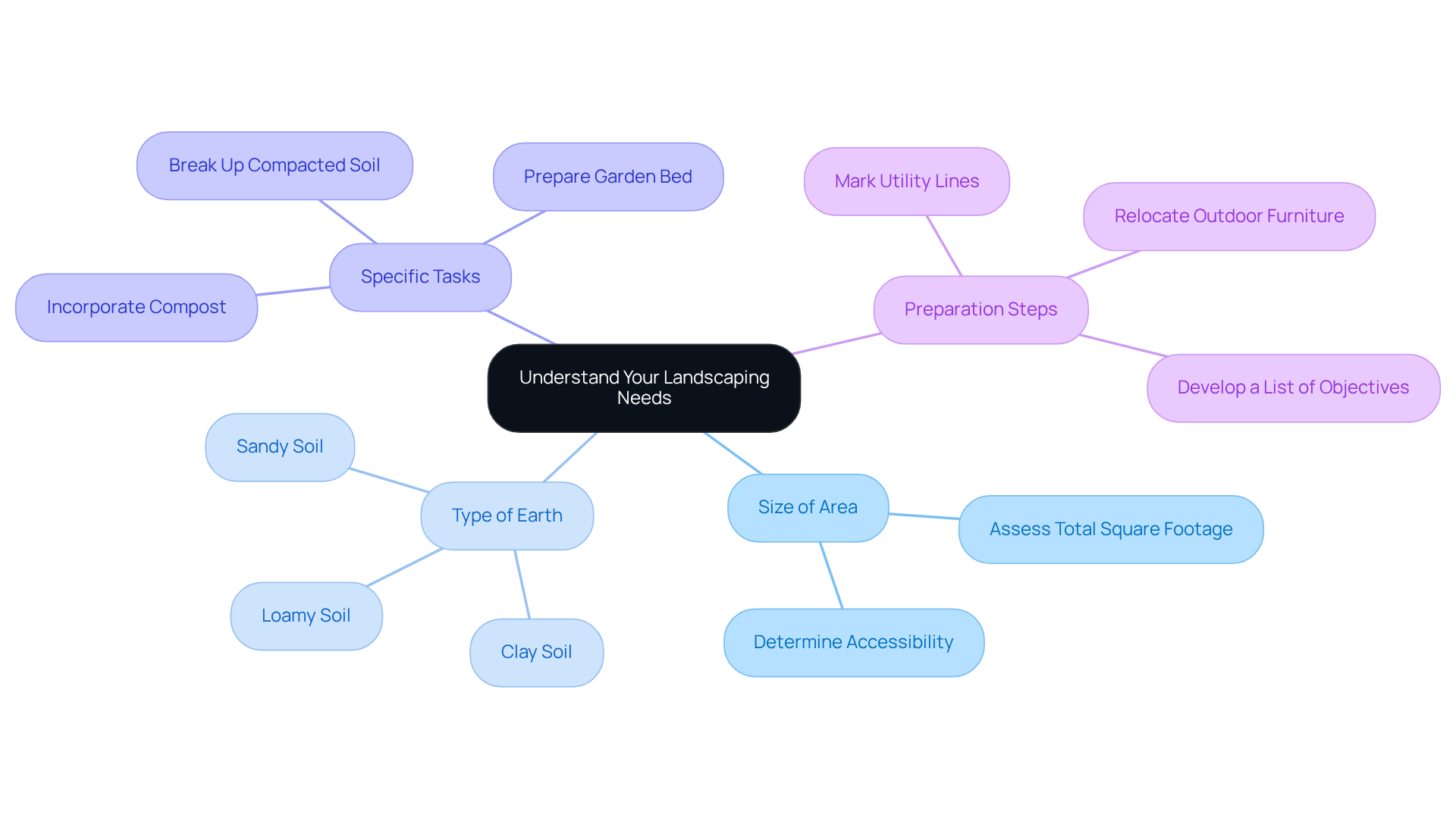
Explore Different Types of Tillers
Selecting the right hire tiller is essential for achieving your landscaping goals, as different hire tillers serve unique functions. Garden cultivators, typically smaller and lighter, are ideal for home gardens, excelling in tasks such as weeding and ground preparation. Weighing between 200 to 350 pounds, these cultivators range in price from $500 for the smallest models to $3,000 for high-end options. In contrast, rear-tine cultivators are built for durability, designed for larger spaces and tougher ground conditions, effectively breaking up compacted earth. Meanwhile, front-line cultivators offer improved maneuverability, although their performance may wane in challenging soil conditions.
When selecting a cultivator, it is crucial to consider key features such as:
- Engine size, which should ideally be around 150cc or greater for gas-powered models.
- Tilling width, which can vary from 8 to 36 inches.
- Adjustable depth settings, providing versatility for tasks from deep tilling to surface weeding.
It’s important to recognize that cultivation equipment generally operates at depths of 6-8 inches, which can present safety hazards if not managed properly.
Experts underscore the significance of understanding these distinctions. A gardening expert notes, "selecting the appropriate tool based on your particular gardening requirements can greatly enhance your project's success." Real-world examples reinforce this point: a gas-powered rear-tine cultivator is often recommended for clay soil, while electric front-tine models may struggle unless conditions are optimal. By carefully evaluating your project needs alongside the features of each hire tiller type, you can make an informed choice that enhances your gardening efforts.
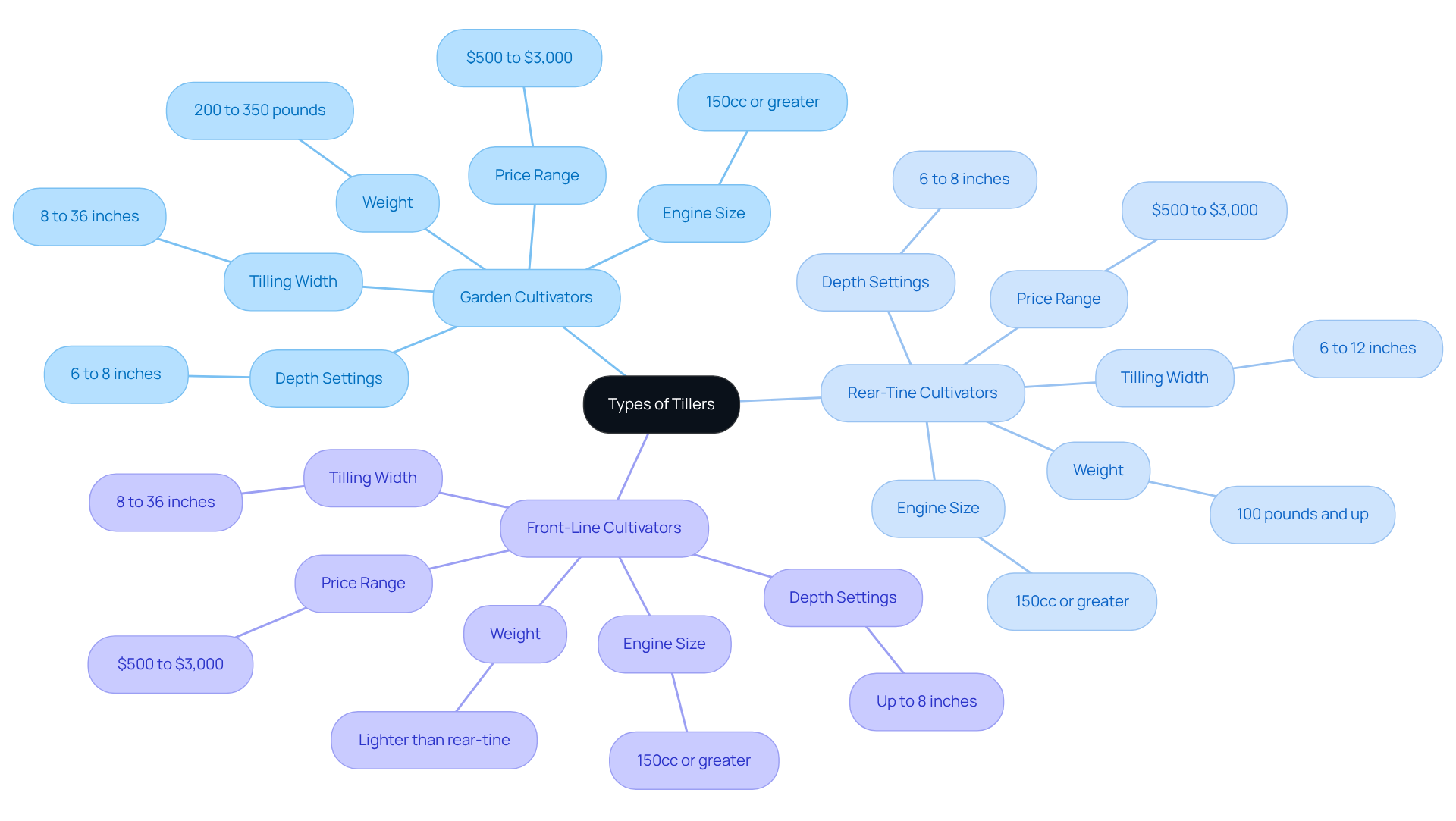
Find a Reliable Equipment Rental Service
Begin your search by investigating local equipment leasing services that specialize in landscaping tools. It is essential to pay close attention to customer reviews and ratings, as these insights are vital for assessing the reputation of leasing companies.
For example, EZ Equipment Rental distinguishes itself in the Dallas-Fort Worth area with its extensive inventory and dedication to exceptional customer service.
Reach out to potential leasing services to inquire about their hire tiller options, availability, and any additional services they may provide, such as delivery or maintenance assistance. This proactive strategy will help ensure you choose a dependable partner for your landscaping projects.
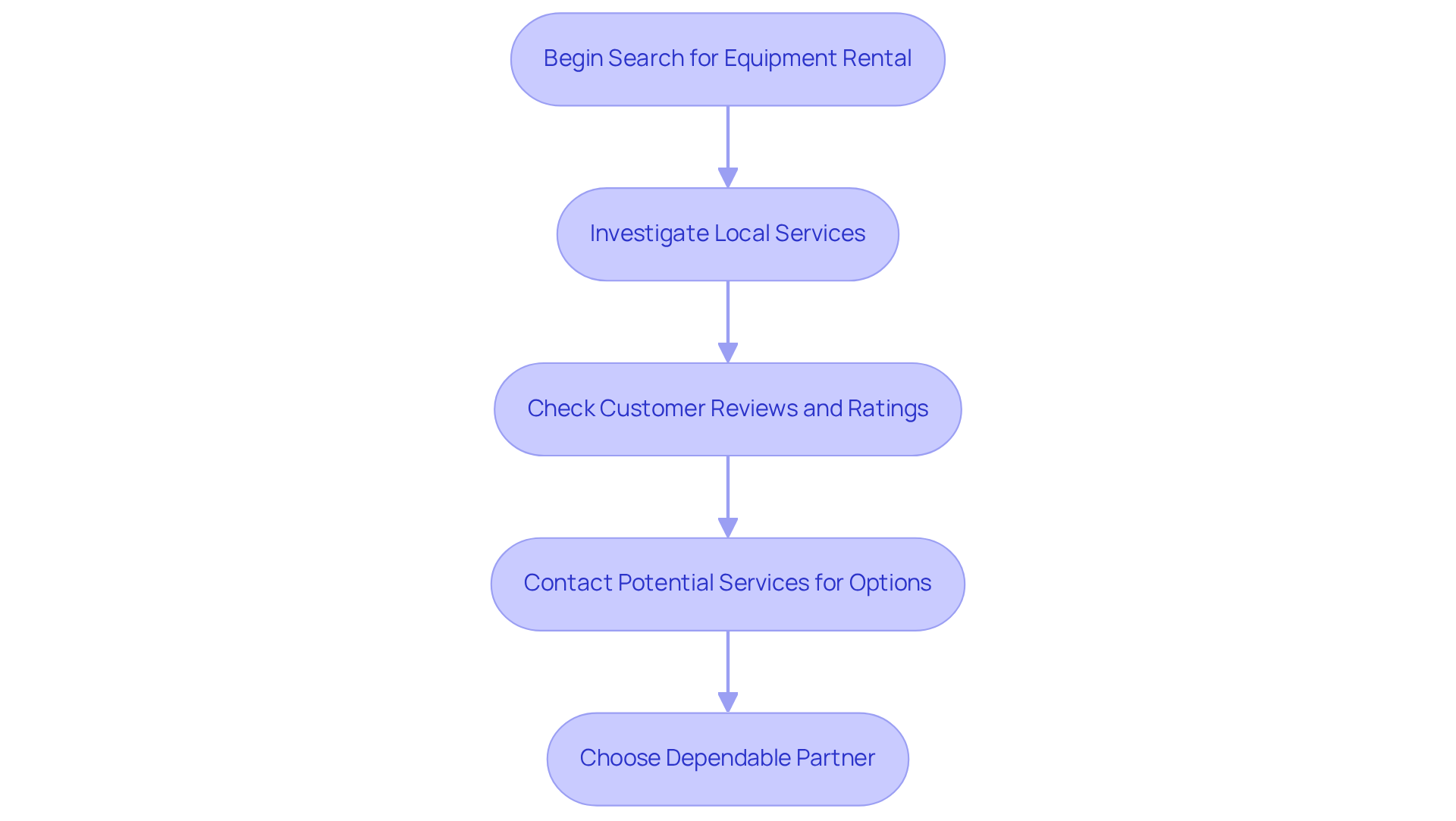
Review Rental Terms and Conditions
Before concluding your lease, it is essential to conduct a thorough review of the terms and conditions of the agreement. Focus on critical elements such as:
- Lease duration
- Pricing structure
- Deposit requirements
- Potential charges for late returns or damages
Understanding maintenance responsibilities during the lease term is vital, and inquiring about insurance options can provide protection against unforeseen events. Clear communication with the leasing service is paramount; it can significantly mitigate misunderstandings and establish mutual expectations. For example, documenting any defects in the equipment upon receipt can protect against disputes regarding damage assessments later. Additionally, being informed about standard pricing models and lease lengths can empower you to negotiate better terms, ensuring a more cost-effective leasing experience.
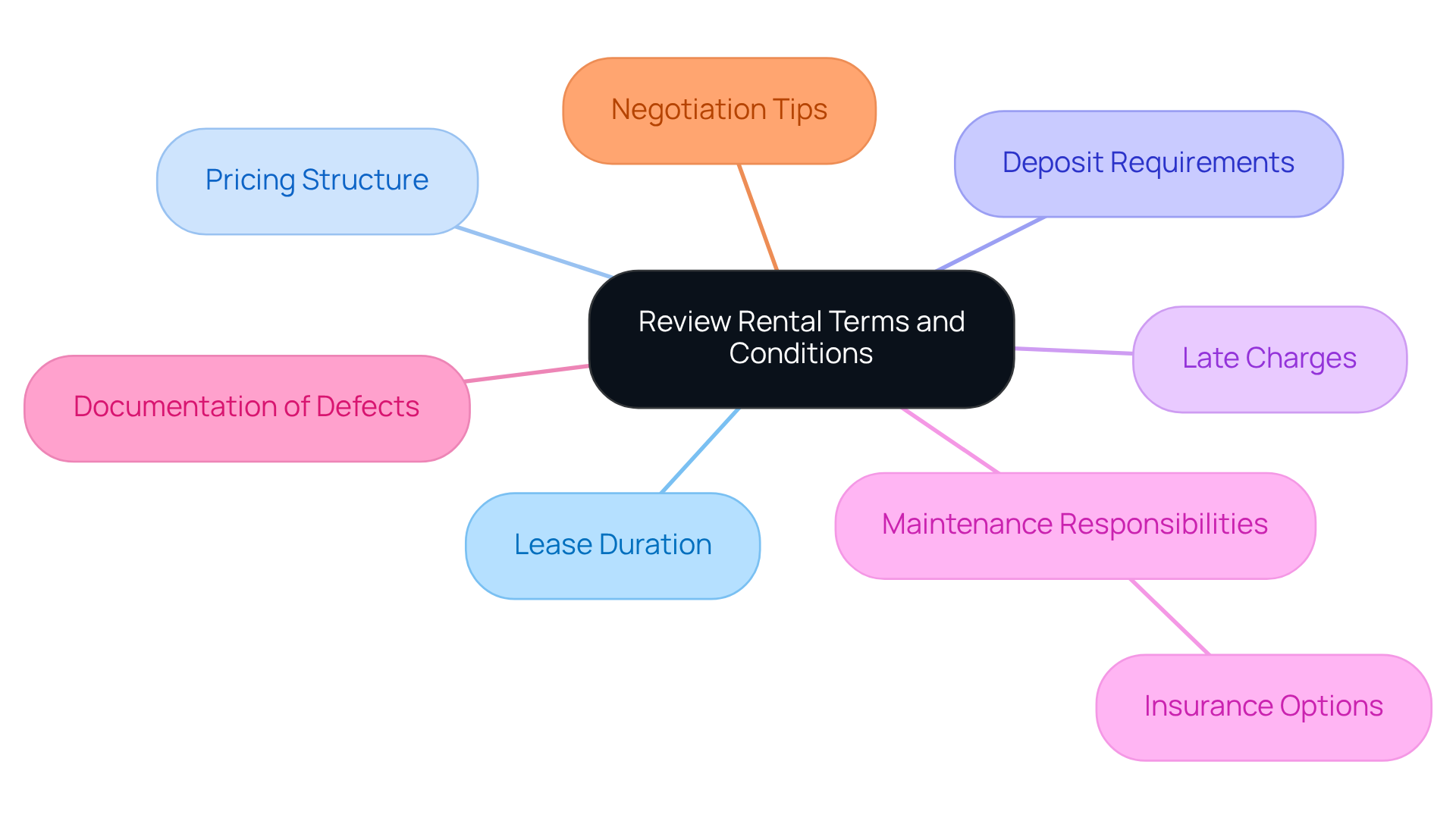
Operate and Maintain the Tiller Properly
When you hire a tiller, the very first step is to thoroughly read the user manual provided by the rental service. This crucial document contains essential information regarding the equipment's operation and safety features. It is vital to wear appropriate safety gear, including gloves, goggles, and sturdy, rough-soled footwear, to protect against potential injuries, as recommended by experts at Cub Cadet.
Before you begin, conduct a test run in a small area to familiarize yourself with the controls and operation of the equipment. After each use, cleaning the equipment and checking it for any damage or wear is imperative, ensuring it is returned in good condition to avoid extra charges.
Common maintenance issues with a hire tiller include:
- Listening for unusual sounds or vibrations during use, which may indicate a need for immediate attention.
- Users report that front tine cultivators can last 8-10 years with proper upkeep, underscoring the importance of following these practices.
Should any problems arise, promptly contact the rental service for assistance. Furthermore, never make adjustments to the hire tiller while the engine is running, as this is a critical safety measure. Adhering to these practices not only enhances safety but also prolongs the life of the equipment, ensuring a successful landscaping project.
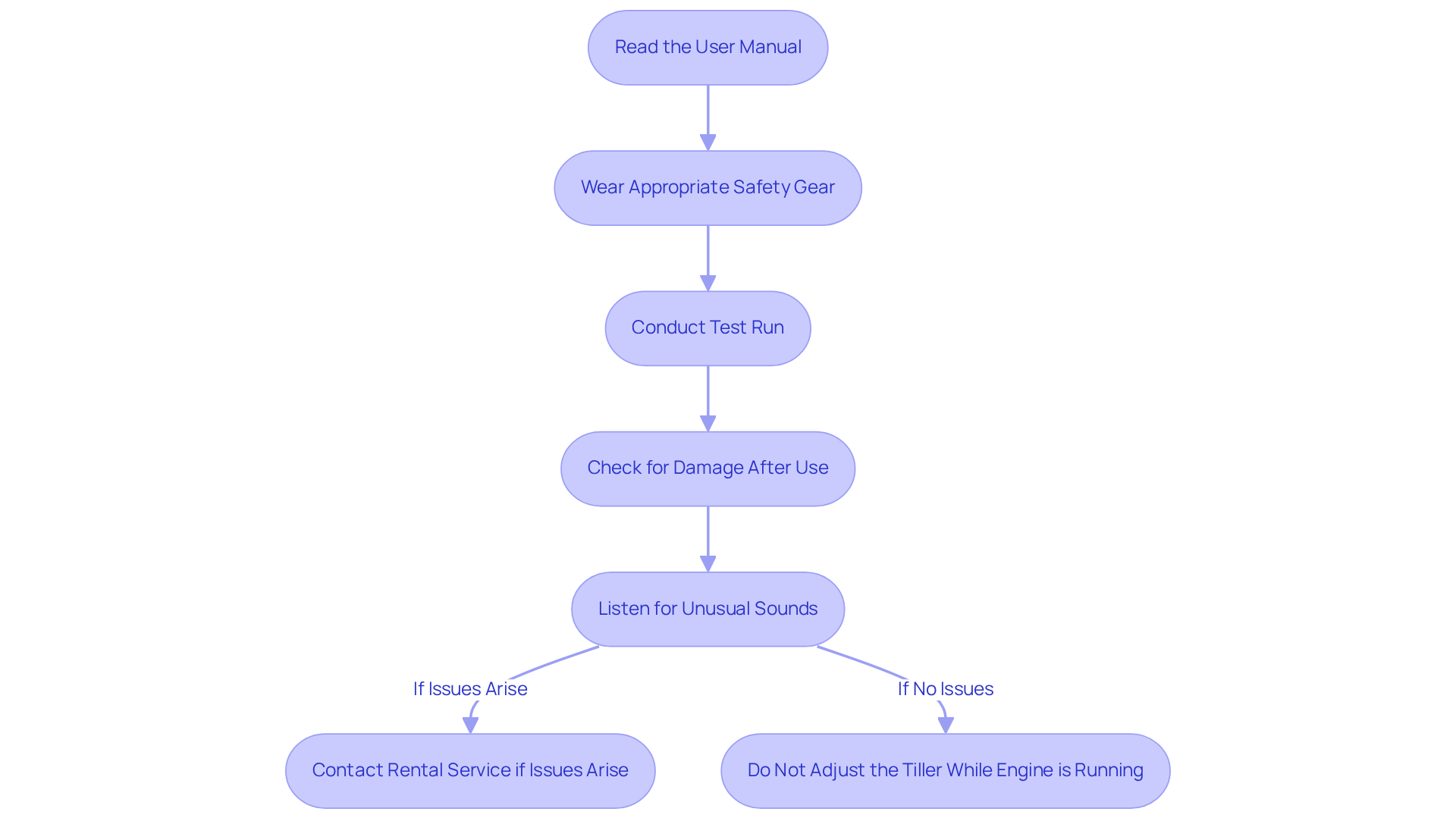
Conclusion
Understanding the process of hiring a tiller for landscaping projects is crucial for achieving the desired results. By assessing landscaping needs, exploring different types of tillers, and finding a reliable rental service, individuals can ensure they select the right equipment for their specific gardening tasks. Properly reviewing rental terms and maintaining the tiller during use further enhances the overall experience, leading to successful project outcomes.
Key points discussed include:
- The importance of evaluating the size and type of soil
- The distinct functions of various tillers
- The necessity of thorough research into rental services
Furthermore, understanding the terms of the rental agreement and adhering to operational guidelines are crucial steps that can prevent misunderstandings and ensure safety.
Ultimately, taking the time to plan and execute these steps not only streamlines the landscaping process but also fosters a greater appreciation for gardening endeavors. By following these best practices, individuals can confidently approach their landscaping projects, making informed decisions that contribute to their success and satisfaction.
Frequently Asked Questions
What should I consider before hiring a tiller for my landscaping project?
Before hiring a tiller, assess the size of the area you plan to work on, the type of earth (sandy, clay, or loamy), and the specific tasks you aim to accomplish, such as breaking up compacted soil or preparing a garden bed. Additionally, prepare your property by marking utility lines and relocating outdoor furniture.
What are the different types of tillers available for hire?
The main types of tillers available for hire include garden cultivators, rear-tine cultivators, and front-line cultivators. Garden cultivators are smaller and ideal for home gardens, while rear-tine cultivators are built for larger spaces and tougher conditions. Front-line cultivators offer improved maneuverability but may perform poorly in challenging soil.
What features should I consider when selecting a tiller?
Key features to consider when selecting a tiller include engine size (ideally around 150cc or greater for gas-powered models), tilling width (which can vary from 8 to 36 inches), and adjustable depth settings for versatility in tasks.
What are the typical operating depths for cultivation equipment?
Cultivation equipment generally operates at depths of 6-8 inches, which can present safety hazards if not managed properly.
How can understanding different tiller types enhance my gardening project?
Understanding the distinctions between tiller types allows you to select the appropriate tool based on your specific gardening requirements, which can greatly enhance your project's success. For example, a gas-powered rear-tine cultivator is often recommended for clay soil, while electric front-tine models may struggle in less optimal conditions.
Why is it important to understand the type of earth before hiring a tiller?
Different types of earth require distinct approaches for effective tilling. Knowing the type of soil helps in selecting the right equipment and ensuring successful gardening outcomes.




